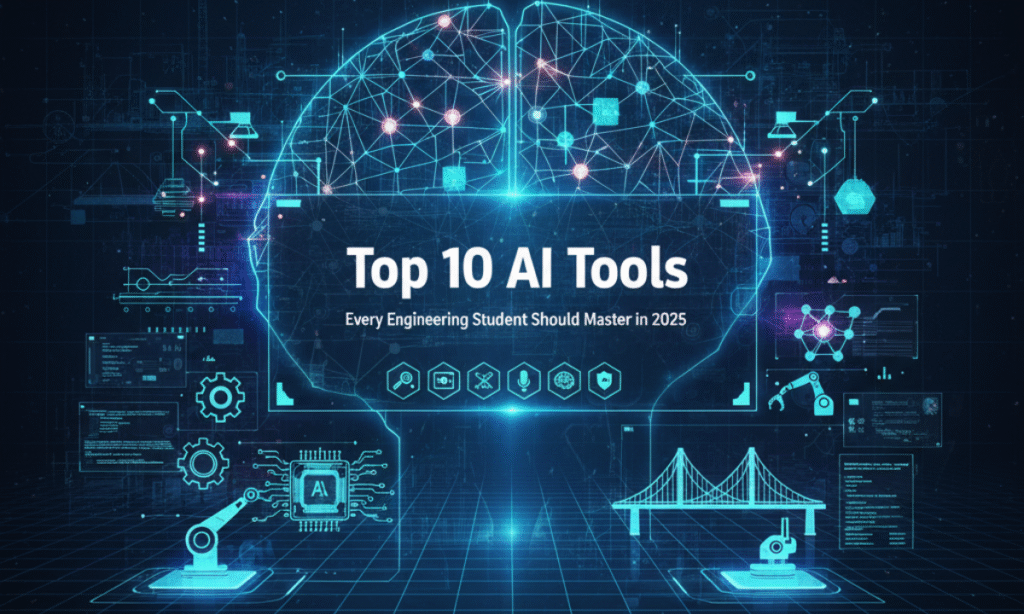
Discover 10 powerful AI tools that can help engineering students manage projects, simulations, and designs efficiently. Learn how tools like Kroolo, PyTorch, TensorFlow, and Autodesk Fusion 360 can boost productivity and creativity.
Artificial Intelligence is no longer optional for engineering students—it’s becoming essential for academic and professional success. From managing complex projects to running simulations, AI can streamline tasks, enhance creativity, and save hours of manual work.
Whether you’re pursuing a B.E. or B.Tech, learning to work with AI tools early on can give you a competitive edge in the job market. In this article, we explore 10 AI tools that every engineering student should know and how they can transform your workflow.
Why AI Is Crucial for Engineering Students
AI integration in engineering education brings multiple advantages:
- Design Optimization – Create better designs in less time.
- Rapid Prototyping & Testing – Test your models efficiently using simulations.
- Data-Driven Decision Making – Analyze large datasets quickly for accurate insights.
- Cost and Risk Reduction – Predictive analytics identify potential failures early.
- Smart Manufacturing – Leverage robotics and automation for precise production.
- Sustainable Design – Save resources and design eco-friendly projects.
By mastering these AI tools, students not only complete assignments faster but also gain hands-on experience with industry-standard technology.
Top 10 AI Tools for Engineering Students
1. Kroolo
Kroolo is an AI-powered assistant that helps students with:
- Project creation and documentation
- Converting voice notes into text
- Generating reports automatically
- Managing class notes and team discussions
For example, you can ask Kroolo: “Create a project report for my drone wing prototype,” and it generates the report instantly. Students can also upload blueprints or CAD files and query the AI directly.
2. PyTorch
PyTorch is a powerful AI and machine learning framework. Ideal for deep learning and computationally intensive tasks like:
- Autonomous vehicle simulations
- Neural network development
- AI research projects
It provides practical experience in building and testing AI models, preparing students for real-world applications.
3. Caffe
Caffe excels in real-time machine vision and image processing, useful for:
- Facial recognition
- Object detection
- Computer vision-based projects
Its speed and simplicity make it perfect for students tackling vision-oriented assignments.
4. TensorFlow
Google’s TensorFlow is highly versatile and widely used in AI:
- Robotics projects
- Predictive maintenance
- Scalable machine learning applications
Its high-level APIs allow students to build complex AI models without deep programming expertise.
5. Mintlify Writer
Mintlify Writer automates code documentation, saving time on large projects and capstone assignments. Proper documentation ensures clarity and professionalism in reports.
6. Bugasura
Bugasura is an AI-powered bug tracking tool. It helps teams identify and track bugs efficiently, making collaboration on software projects smoother.
7. Sourcegraph Cody
An advanced coding assistant that:
- Analyzes large codebases
- Helps with debugging
- Simplifies learning new programming languages
- Streamlines project management
Ideal for students working on multi-module projects or complex software assignments.
8. Autodesk Fusion 360
A complete 3D design, CAD, CAM, and CAE platform, useful for:
- Prototyping designs
- Simulation and testing
- Manufacturing planning
It’s particularly valuable for mechanical, civil, and robotics engineering students.
9. MATLAB
MATLAB is essential for:
- Data analysis
- AI modeling
- Signal processing
- Control systems simulations
It gives students the ability to experiment with complex computational models.
10. Simulink
An add-on for MATLAB, Simulink is perfect for model-based design:
- Automotive and aerospace simulations
- Robotics systems testing
- Dynamic system modeling
Together with MATLAB, it allows students to simulate and optimize engineering designs before physical implementation.
Benefits of Using AI Tools for Engineering Students
- Efficiency: Automate repetitive tasks and speed up project completion.
- Creativity: Focus on innovative solutions while AI handles calculations and documentation.
- Industry Readiness: Gain practical experience with tools used in real-world engineering.
- Collaboration: AI tools enhance teamwork by simplifying communication and code/document management.
Conclusion
AI is transforming engineering education. By adopting tools like Kroolo, PyTorch, TensorFlow, and Fusion 360, students can complete projects faster, reduce errors, and focus on innovation.
Starting to use these tools during college not only improves academic performance but also gives students a head start in the competitive job market. The future belongs to engineers who can blend traditional knowledge with AI-powered efficiency.
FAQ: AI Tools for Engineering Students
1. Are AI tools necessary for engineering studies?
Yes, AI tools help manage projects, run simulations, and optimize designs, making them almost essential in modern engineering curricula.
2. Can beginners use these AI tools?
Most tools like Kroolo and Mintlify are beginner-friendly. Advanced tools like TensorFlow or PyTorch require some programming knowledge but are learnable with practice.
3. Which AI tool is best for design projects?
Autodesk Fusion 360 and MATLAB/Simulink are ideal for design, prototyping, and simulation.
4. Do these tools help in job preparation?
Absolutely. Familiarity with AI and machine learning frameworks significantly improves employability in AI-driven engineering roles.
5. Can AI replace manual engineering work?
Not entirely. AI assists with optimization, simulation, and documentation but creativity, problem-solving, and practical insights still require human input.